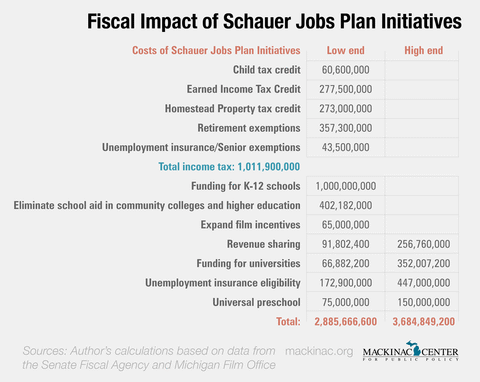Schauer Jobs Plan Pricetag: $3.7 Billion
Without offsetting cuts or taxes, candidate’s 'Blueprint' blows big hole in state budget
At a time when state spending has reached a record high, proposals in a "Jobs Blueprint” posted on Democratic gubernatorial candidate Mark Schauer’s website would increase it by about $3.7 billion, according to an analysis by the Mackinac Center for Public Policy.
The extra money would go to public schools, universities, community colleges, film subsidies, state revenue sharing payments to local governments, higher unemployment benefits, universal pre-school programs and more.
Schauer offers few details on how he would pay for the increases beyond non-specific suggestions like “cut wasteful spending to save taxpayer dollars,” "review state contracts" and “make government more efficient and effective.”
The new spending would be added to the latest state budget which is a record $30.04 billion according to the Senate Fiscal Agency. It is $53.29 billion when federal dollars are included, also a record. New records were also set in last year’s budget.
“There is nothing complicated here,” said Charles Owens, state director of the National Federation of Independent Business, referring to Schauer’s blueprint. “This is the same old song book that (former Gov.) Granholm sang from. And that is, ‘Spend more money than you take in. Go to the business community and treat them like an ATM to finance the overspending and sit back and wonder why there are no jobs.’”
Here are the costs of the plan provisions directly able to be estimated, according to the Center's analysis (click to enlarge):
(Note: Some of the proposed initiatives are vague so the cost estimate is a range. Other recommendations were clear enough to be estimated without a range.)
Schauer’s proposals include measures like “restoring” state university spending levels. This year, $1.419 billion was appropriated for higher education. Increasing the amount to 2011 levels — the last budget approved by Gov. Granholm — would mean a $66.9 million increase. But spending on universities has been decreasing over the long term. Going back to 2008 funding levels would add $352 million to the current budget.
The plan also calls for “expanding Michigan’s movie and television incentives,” but does not specify exactly how much more Schauer wants for these film subsidies. This year, $50 million was appropriated. As originally enacted in 2008, the program had no cap on annual subsidies; in the final year before spending was capped, $115 million had been awarded to producers. Returning to this level would cost taxpayers an extra $65 million annually.
Schauer and his political allies have promoted a claim that Gov. Snyder “cut $1 billion from K-12 education,” and his plan calls for “reversing Rick Snyder’s devastating cuts.” The claim has been widely debunked. Because of the lack of specificity in his calls for more education spending, the analysis interprets his calls as a recommendation to spend $1 billion more on public schools (the current amount is $12.06 billion).
Other parts of the plan include reversing changes made as part of a comprehensive business and income tax overhaul enacted in the first months of Gov. Snyder’s tenure. Among these was the elimination of a child tax exemption; reductions in “Earned Income Tax Credit” subsidies for lower income workers; placing income caps on homestead property tax credits; repealing exemptions for seniors and some pension income, and for income from unemployment insurance benefits. Reinstating these without offsetting spending cuts or tax increases would unbalance the state budget by an additional $1.01 billion.
Although Schauer has criticized Gov. Snyder for “his $1.8 billion business tax cut,” he also says he doesn’t want to increase the 6 percent state tax currently imposed on business earnings, or the state gas tax.
“Schauer’s plan blows a huge hole in the budget,” said James Hohman, assistant director of fiscal policy at the Mackinac Center, who did the analysis. “His gestures toward reviewing state contracts is not a plan to pay for his spending increases.”
The cost estimates for Schauer’s proposals are listed in the table above. The analysis features a range of costs for some items because parts of the plan are vague. The fiscal impact of the initiatives are relatively conservative because several items listed that would likely cost more money were not able to be quantified.
For example, the plan calls for creating a "Michigan In-Sourcing Initiative," but provides no details that would allow for a cost assessment.
The plan also calls for "fixing the roads," but no specific spending plan is highlighted.
Only direct costs to the state budget were considered. Other recommended changes, like increasing the state's renewable energy standard to 30 percent, would have economic costs but were not quantified as budget impacts.
The Schauer campaign did not respond to a request for comment.
~~~~~
See also:
All Four Teachers in New Schauer Ad Claiming School Cuts are in Districts Receiving More Money
Democrat Mark Schauer Receiving the Big Donations in Gubernatorial Race
Gubernatorial Campaign Should be About Things That Matter
State Budget Has Increased Almost $5 Billion the Past Three Years
Michigan Capitol Confidential is the news source produced by the Mackinac Center for Public Policy. Michigan Capitol Confidential reports with a free-market news perspective.


 Six-figure salaries increase by 474% at Michigan health department
Six-figure salaries increase by 474% at Michigan health department
 Lawmakers spike $50 million request for copper mine
Lawmakers spike $50 million request for copper mine
 State Board of Education pushes ‘fair share’ tax for cradle-to-grave public school mandate
State Board of Education pushes ‘fair share’ tax for cradle-to-grave public school mandate